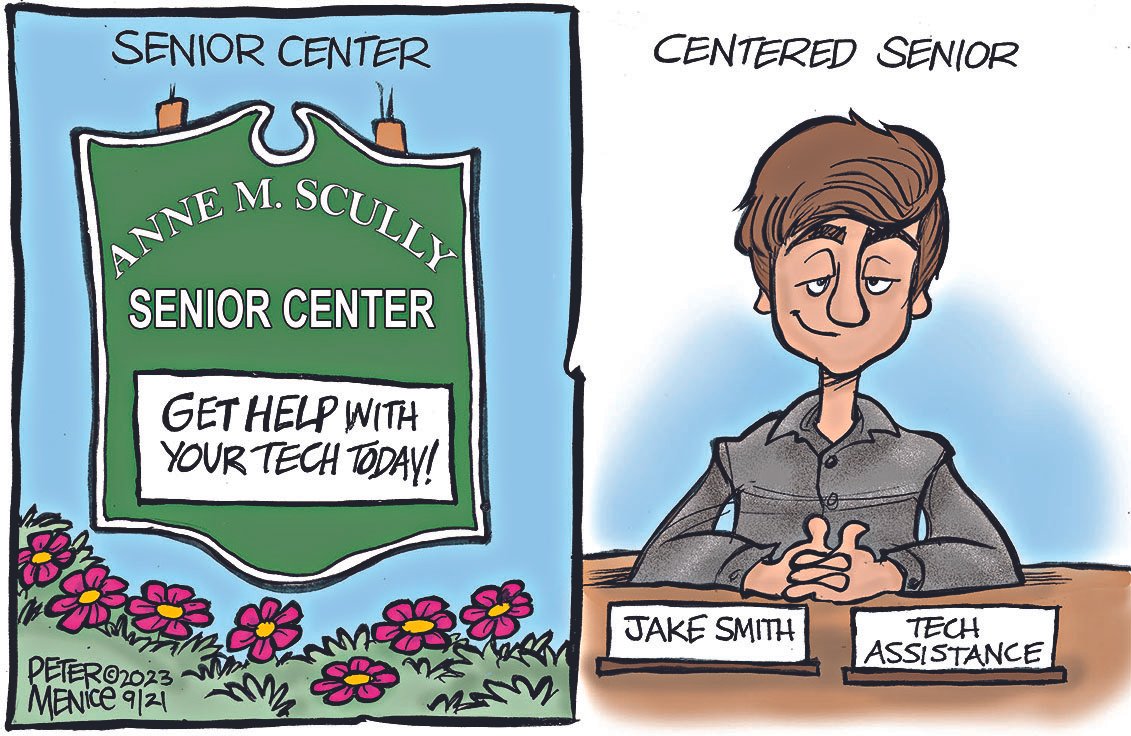Hampton Circle neighbors say playground reconstruction will worsen flooding in area
/By Dolores Sauca Lorusso
As work progresses on reconstructing the Hampton Circle playground, neighbors are raising concerns that the project will worsen flooding in the area.
A meeting at the playground on Tuesday evening drew a sizable crowd that said the higher elevation of the play structure will spread negative impacts from flooding and pooling rain. Abutters from the streets surrounding the playground – Marginal Road, Moreland Avenue, Hampton Circle, and Bay Street – attended the meeting called by Director of Community Development and Planning Chris DiIorio to voice their experiences with flooding and drainage.
“They changed the topography of the playground. After all the landfill, water can’t move through and is flowing into all the other yards,” said Ellie Destito, who has lived on Marginal Road for 28 years. “When the waves from the bay come in, it is almost like the grand rapids.”
The playground is dedicated to U.S. Navy Lt. Joseph D. McLaughlin, who died in World War II. McLaughlin’s family lived on nearby Lincoln Avenue for decades. The playground is the beginning and ending point of the neighborhood’s annual Fourth of July parade.
According to DiIorio, when the town was forced to remove the playground due to the condition of the equipment, there was “an outcry from the neighborhood to construct a new playground.
The neighbors, parks and recreation, the select board, the community preservation committee, and town meeting were all in favor of moving forward with a new playground there.”
Jim Richman, who was present at the meeting as a citizen, although he is a member of the CPC, said they were never told the height was being raised and the memorial monument would be moved.
DiIorio said the CPC is not a permitting authority, nor does it review specific details of each project. The CPC makes recommendations to town meeting for funding of projects based on the purpose of the project and what it will provide for the community.
“Flooding is not a volume issue, there is not more water as a result of the fill,” Gary James, civil engineer of Beta Group, told the neighbors.
However, the abutters disagreed. The group stressed even with drainage, all their homes are in “jeopardy.” Destito said the abutters were told to “wait and see storm impacts… but what about people who own homes? Are we not more important than a playground?”
DiIorio told the Times the engineers were aware of the flooding, but told him, “raising it (the land) would not cause the flooding to get any worse.” He explained the playground was elevated due to the water, to prevent consistently flooding the equipment and pour-in-place playground surface.
“We wanted to protect the playground for sure, but are absolutely concerned about people’s houses,” said DiIorio.
Some abutters believed the elevated height was to protect the warranty, but DiIorio confirmed in an email that rainwater or saltwater touching the structure or poured-in-place surface does not void the warranty.
“However, if it’s under water every month, I think the companies issuing the warranty would be able to make an argument that that it is not a proper environment for the structure,” he said. “Elevating the playground will significantly reduce the number of times the playground is inundated as opposed to the first design.”
“I am not a direct abutter, but came out to support my neighbors,” said Dan Kernan, resident of Hampton Circle and vice chair of the redevelopment authority. “The water flow wears away at the little beach, I watch the water flow over the cement wall… the area turns into a big lake. The neighbors come out with kayaks.”
Beth Chapman of Moreland Avenue said she likes the playground, but is having a major drainage issue.
“All the stormwater is directed to the storm drain in front of my property and it does not work,” she said. “It comes down the hill and bypasses the catch basin and ends at the front of my house…all the water goes under my house and the foundation is eroded.”
Bryan Fenelon of Bay Street questioned whether anyone truly understood how the drainage works and why a study was not done.
“Water bypasses the drain and goes down the other side of the fence… the water is finding the easiest way to go and that is into the yards of abutters,” he said. “Reality is much different from paper.”
“There is a difference between lived experience and technical experience,” said Liz Kay of Hampton Circle. “Even if it is only 1% of the time, when it is acting like a river between Marginal to Moreland, the impacts on abutters make addressing the issue more important than the playground.”
DiIorio said a drainage study was not needed at the time because the town was not changing the drainage and the ground was graded to work with the existing drainage system. Abutters disagreed, and said they believe the drainage system was impacted because fill was added to change the elevation.
“All the water that went to the drainage system before will continue to go to the drainage system,” said DiIorio, who also recognized the drainage may not be working as well as it should.
“DPW tried to fix the problem with a catch basin. That is not our part of the project,” said Dave McKinley, landscape engineer from Beta Group. “The drainage pipes are dead flat; the pitches are miniscule… [We] need to do some drainage studies; when we did the project, we did not survey all the way to the other end toward the bay.”
“The town has an approved grant to provide funding to contract with an engineering consultant to do an existing-conditions analysis and make recommended improvements to the drainage system in that area,” said DiIorio, who expects the report to be completed by the middle of next year.
Some abutters said they were frustrated with what they saw as “double standards” because local rules that prohibit them from making changes to their property that have been made at the playground.
“The conservation commission would not allow me to put tar in my driveway, like they have here (playground), because it could not drain,” said Larry Robicheau of Moreland Avenue. “When it is pouring the park is protected, not our homes, but there are no kids here in the pouring rain.”
Linda Dunphy of Andrew Road articulated her “disappointment” in the process.
“As beautiful as it is, I don’t think they heard one word we said, not one word,” she said. “We want to not have water in people’s yards and houses and want to move the memorial monument back to where it originally was.”
Although the memorial monument to Lt. McLaughlin was put in facing in toward the park and will not be moved back closer to the road so passersby can more easily view it, DiIorio confirmed that the inscription will be made double-sided so it can be read from the street.
Some, like Richman, are concerned that kids will climb on the memorial.
“Shifting the memorial was secondary and how they treated it is unsettling…it is a memorial park and not just a playground,” Kay said.
“Our concerns are falling on deaf ears…The playground is trumping our homes,’ said Eileen Weisslinger of Hampton Circle.
Do you have an opinion on this issue? Click here to write a Letter to the Editor.






















